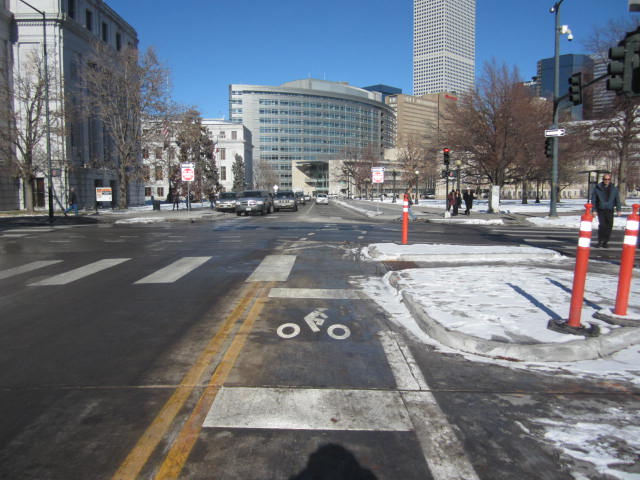People on bicycle trying to get into Downtown from the south just got help from Public Works. This summer, the city opened the first cycle track in Denver, which is defined by the degree of separation from other forms of traffic. Unlike a bike lane or buffered bike lane, a cycle track is separated from auto traffic by more than just paint. Usually the cycle track is curb-separated and at a slightly different grade than the road bed for automobiles. This is the case with Denver’s first cycle track, which runs along Bannock Street in front of the City and County Building.
The new cycle track on Bannock is marked by black pavement designed to blend with the historic Civic Center Park it borders. (click on images to enlarge)
The North bound Bannock cycle track runs counter to the South bound one-way traffic on Bannock to provide access to Downtown Denver from the Golden Triangle / Capitol Hill neighborhoods. To make the movement work, Public Works added some innovative pavement treatments at the intersection of 14th Avenue and Bannock. From left to right: 1. Bike lane transition to the left. 2. Bike Box. 3. Intersection path across 14th Avenue. (click on images to enlarge)
- As a cyclist approaches the cycle track entrance heading north on Bannock, the bike lane transitions from the right side of the traffic lane to the left side of the traffic lane.
- At the intersection, the cyclist is provided with a bike box where they can wait for the signal to turn green to move across the intersection and onto the cycle track.
- A path has been marked across the intersection to clearly denote the path a cyclists should take to enter the cycle track.
The new bike signal, intersection treatments, and cycle track represent a new level of complexity in bicycle-specific traffic design for Denver. As the city moves to make Downtown more accessible to people on bicycles, these kinds of treatments will be key. I hope that the city will be as innovative and forward thinking as they design the connection from the Bannock street cycle track across Colfax linking to the proposed cycle track on 15th Street through Downtown. This segment of the network is currently under study and should be installed in 2012.
In the meantime, I suggest the following great bike ride in Downtown Denver. Ride up the new 14th street bike lane, and enjoy the views and streetscape of Denver’s just completed “Ambassador Street.” At Colfax, head south on the Bannock bike lane and visit the new Clyfford Still Museum at 13th and Bannock. When you’re done there, head back into Downtown on the new cycle track. With these great new investments, it’s clear that Denver really is on the right track!
Bicyclists “multi-tasking” on just opened 14th Street bike lane.















For all those who complain that cyclists never follow traffic laws, I think they will be surprised to see that we will follow the rules when streets accommodate us and are designed with our safety in mind. nice work denver.
I like it when cyclists follow the law when I am driving, cycling, or walking – because then I know exactly what rules they’re going to go by. Lots of times I get run over by cyclists cruising through red lights when I am a pedestrian downtown.
But cyclists have it pretty bad. If you follow the law and wait for a red light and a car is behind you that needs to make a right turn, that car is gunna get pretty upset that you’re not moving out of their way.
I hope these lanes help all parties.
Is that 14th Street guy talking on the phone? Not a smart thing to do on a bicycle. I also note that a part of the Chicago skyline appears in this photo–an interesting juxtaposition.
But this is great news, and I can’t wait to try out these new improvements.
That’s nothing. In Amsterdam, I’ve seen (literally) a guy bicycling while smoking, talking on the cell phone and holding an umbrella all at once!
i rode by tonight to check it out. i assume there is no standard design for such bike infrastructure and the city is learning as it goes, but the light really should have been placed on the south side of the intersection. it is very hard to spot from across the street especially since we are not used to looking for this type of light.
Also the light should be at Bike Riders height level!
There are standards, but I would reckon they’re in Dutch.